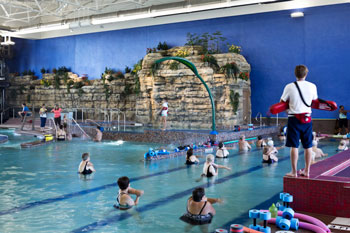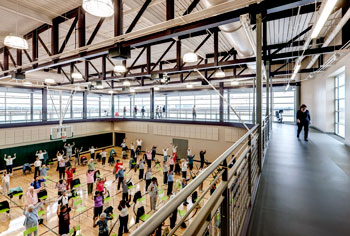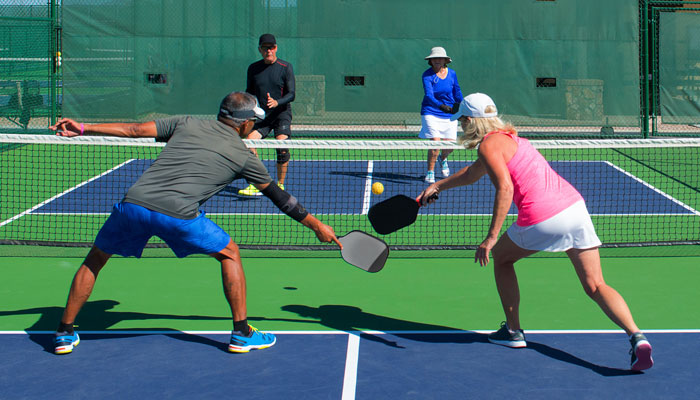One key thing for facility operators to remember when planning to increase space, equipment and programming for seniors is to not call the target audience seniors.
“Organizations catering to the older population must comprehend that people today perceive themselves as younger at an older age,” said Colin Milner, founder and CEO of the International Council on Active Aging. “They hold a belief in their ability to accomplish feats that previous generations might not have envisioned.”

Milner said attitudes toward older people began to change after a groundbreaking Tufts University study in the 1990s revealed that they could improve their physical capabilities rather than stay resigned to inevitable inactivity. While adaptation to this new thinking has continued since then, it’s still common to call older people seniors and senior citizens, Milner said.
The industry has made strides in understanding the needs, expectations and aspirations of the older population, he said, although there is room for improvement to fully appeal to this demographic. Despite innovations, the language used has not always kept pace.
“The persistent use of terms like ‘senior programs’ remains a turn-off for many older adults, particularly those from the baby boomer and Gen X generations,” Milner said. “The key shift should be toward a focus on aspirations, interests and capabilities rather than age.”
That doesn’t mean there should be no accommodations or programs for the older members of communities served by recreation centers, only more care in labeling them. Stephen Springs, senior principal with Brinkley Sargent Wiginton Architects, a firm that has helped several facilities improve their buildings’ offerings to older people, has seen the group’s distaste for the ‘senior’ tag enough to agree with Milner. He’s even felt it, having turned 50 several years after his firm began working in the older people recreation space. You can get an AARP card at 50, and it’s not uncommon for senior centers to invite those who have turned 55.
“I was always thinking of seniors as other people,” the 51-year-old Springs said. “I was working on these projects, and last year, I kind of had the realization: I could be a member. I don’t like how that sounds.”
Milner notes that Pew Research has recently revised its approach to researching the older population, moving away from generational definitions. The change acknowledges the similarities in health goals, capabilities, desires, aspirations and lifestyles among various age groups.
“The industry should move beyond the binary classification of older and younger and concentrate more on individuals’ capabilities, allowing them to embrace programming regardless of age,” said Milner. “For instance, activities like painting classes are not age-specific, and physical activity, such as training for a marathon, is fundamentally the same desire, whether for a 65-year-old or a 70-year-old. Recognizing these shared goals and desires across generations is crucial, emphasizing inclusion over exclusion in fitness programming.”

So what does this mean for facility design, renovation, construction and programming? Springs said it’s more helpful to not only embrace the more positive attitude of what people can do rather than what they can’t, but to think of spaces for our later years as multigenerational facilities.
“Baby boomers refuse to grow old,” he said. “Baby boomers are not your traditional seniors.”
Springs worked on The Summit at Central Park, in Grand Prairie, Texas, touted as the nation’s first baby boomer center. It’s the project that has shaped his thinking on recreational facilities that want to better serve older folks. Its goal has been to accommodate people older than 50, and that customer base could span 40-plus years.
The Summit—named with the philosophy that it’s not about reaching the end but reaching the top—features an indoor leisure pool, spa, walking track, theater and ballrooms. Opened more than 10 years ago, its ballrooms may already be outdated, said Springs, space that might be better used for pickleball than dancing.
Springs said simply put, the generations, perhaps divided less by age than interests and ability, can mix in the middle of the day, when the morning shift of those who come early for the meals and card games blends with those who use the exercise areas. Springs said the divide is at the front desk, where a trip to the left finds the more sedentary activities and to the right leads to the gym and aquatics. In the building’s middle are the social spaces for both groups.
Calie Willis is the recreation manager for the senior and community center in Coppell, Texas. She said if communities want to get into the business of providing recreation to their older population, they should plan for decades not years.
“Exploring how to best meet the needs of the vast majority of ages and stages that qualify for senior adulthood is a task that municipalities and private businesses should continue to invest in,” she said. “Senior adulthood can continue for 40 to 50 years, which means each senior adult is a potential 40- to 50-year-long customer of facilities.”
Willis said there are a number of basic features to consider when a new build or renovation that caters to people older than 50 is being considered, planned and completed. Senior recreation center accommodations reach far beyond ADA requirements, she said.

“Yes, a facility for senior adults should be physically accessible for them, but as technology advances, providing adaptable equipment like screen readers and large-print keyboards can assist senior adults with their technology use,” Willis said. “Many senior adults experience hearing loss, and the background noise found in facilities can augment the loss. Exploring additional soundproofing, reducing the white noise that HVAC systems and other operational systems create and adding AV systems for microphones can help reduce extra noise and amplify needed noise in facilities.”
She said providing restroom locations in relation to the heaviest-traffic areas, as well as reducing the amount of turns to enter restrooms and stalls can also enhance the facilities for older adults.
Because many older adults are retired, with flexibility to spend much of their time in senior recreation facilities, meal services or kitchenette and dining spaces should be taken into consideration. Other accommodations require looking outside of the physical facility, such as transportation services and operation hours outside of the traditional workday.
“Accommodations for senior recreation users are increasing, but as senior recreation professionals, we must stay creative in how we approach the accommodations and reach beyond the bare minimum,” said Willis.
Programming needs to focus on the fitness-minded new generation of elders, said Willis. She said the requests for active programs are increasing, with pickleball and racquetball leading the way.
In addition to the recreation programs, senior adults are invested in the community experience of senior recreation facilities, said Willis. “Senior adults spend double or triple the amount of time in a recreation facility during a single visit than their non-senior counterparts, as they are connecting with other members and building community,” she said. “Creating opportunities through programs and physical space for senior adults to connect with one another is a consideration senior recreation professionals should take.”
Willis said like with most new construction or renovation projects or new programming directions, operators should gather as much input as possible from the community or membership when focusing on older people. She said professionals should seek input from adults in their mid to late 40s alongside the input from adults in senior adulthood.

“As each generation ages, their view and experience of senior adulthood is vastly different than the generation before them,” she said. “For instance, many are actively raising grandchildren or providing regular childcare for their grandchildren. If they cannot bring those children into the facility, that is a barrier to participation.
“The baby boomers are rapidly aging into senior adulthood, and they are challenging the traditional notion of senior recreation. This generation is not content with bingo and is looking to participate in active programs. Including traditional fitness classes alongside modified fitness classes is an opportunity for facilities to accommodate their program offerings.”
With the expected length of retirement increasing, facilities can expect to serve members for two, or even three decades, said Willis. Senior recreation professionals should be consistently seeking to refresh programs or add new programs into the offerings as they serve these long-time members. “Ultimately, start with the users’ experience in mind and then use that to create improvements,” she said.
Springs agrees that input must be gathered and said there are some considerations when conducting surveys. “Your traditional seniors are very territorial, a very opinionated group, so you pretty much have to engage them in the design process, or they will complain that they weren’t engaged,” he said. “I think the problem is when you’re trying to reach out to this new definition of senior. That’s a challenge because sometimes the people you’re targeting aren’t the ones who show up to meetings because they say, ‘I’m not gonna go to a senior center, so I’m not gonna respond to this whenever Facebook posts about, ‘Hey, there’s a meeting at the rec center tonight about a new senior center.’
“A lot of times your target market doesn’t show up, and so you have to find other ways to reach out to them. What would it take to get them to come?”
Springs said there doesn’t need to be a focus on specialized fitness equipment for these age groups but does suggest a furniture consideration: heavier chairs and couches that have a non-absorbent surface.
“Furniture that is very easy to wipe down and clean because accidents happen, but at the same time, you don’t want it to be very sterile and institutional,” Springs said. “We spend a lot of time finding chairs that look like big, fluffy, comfy things, with very sturdy arms so for people who have difficulty standing, there is something that’s secure that you’re pushing off of. It doesn’t look like it belongs in the hospital. It looks like it belongs in a living room, but it still functions.”
Along with pickleball and walking tracks, aquatic facilities are immensely popular with and beneficial for older folks. They’re also the most expensive type of facility to build and operate. “Unlike the perception from 20 years ago when aquatics may have been seen as a social activity for many older individuals, today it is recognized as a fantastic training modality,” Milner said.
One notable shift is the increased understanding that aquatics can benefit people experiencing pain and other health and functional issues, said Milner. This awareness has contributed to the transformation of aquatics into a comprehensive training approach, particularly for older adults aspiring to improve their fitness or treat injuries.
“Aquatic spaces are no longer confined to a place where individuals jump up and down in the pool; they have evolved into aquatic wellness centers,” Milner said. “These spaces may include both indoor and outdoor pools, exercise areas, social gathering spaces and activities that stimulate cognitive function within the pool environment. The design of aquatic spaces has expanded to provide a holistic experience, aligning with the broader shift toward wellness and a focus on overall well-being.”
Milner said without a staff trained for interaction with older generations, beginning with marketing, none of the physical features of a facility matter, especially with new attitudes and goals of future aging customers.
“Our role must align with fulfilling this brand promise, a task that, while not overly challenging, requires effective messaging,” Milner said. “This entails creating a narrative that allows individuals to envision themselves seamlessly integrated into our communities, centers or facilities. Critical to this vision is the recruitment of staff possessing qualities such as empathy, active listening, effective communication and motivational skills. Moreover, these staff members should comprehend the unique challenges associated with working with an older population.”
To effectively attract and cater to the older population, a straightforward approach involves engaging in conversations with older adults to discern their desires and preferences, said Milner.
“Presently, it is evident that they are embracing a comprehensive wellness model that extends beyond mere physical fitness,” he said. “This holistic approach encompasses emotional well-being, spiritual health, vocational engagement, environmental consciousness, intellectual stimulation and social connectivity.
“For organizations seeking to serve this demographic successfully, it is imperative that both the built environment and the services offered align with and embrace this multifaceted wellness model. This entails a more significant commitment and integration than what may have been traditionally practiced.” RM



